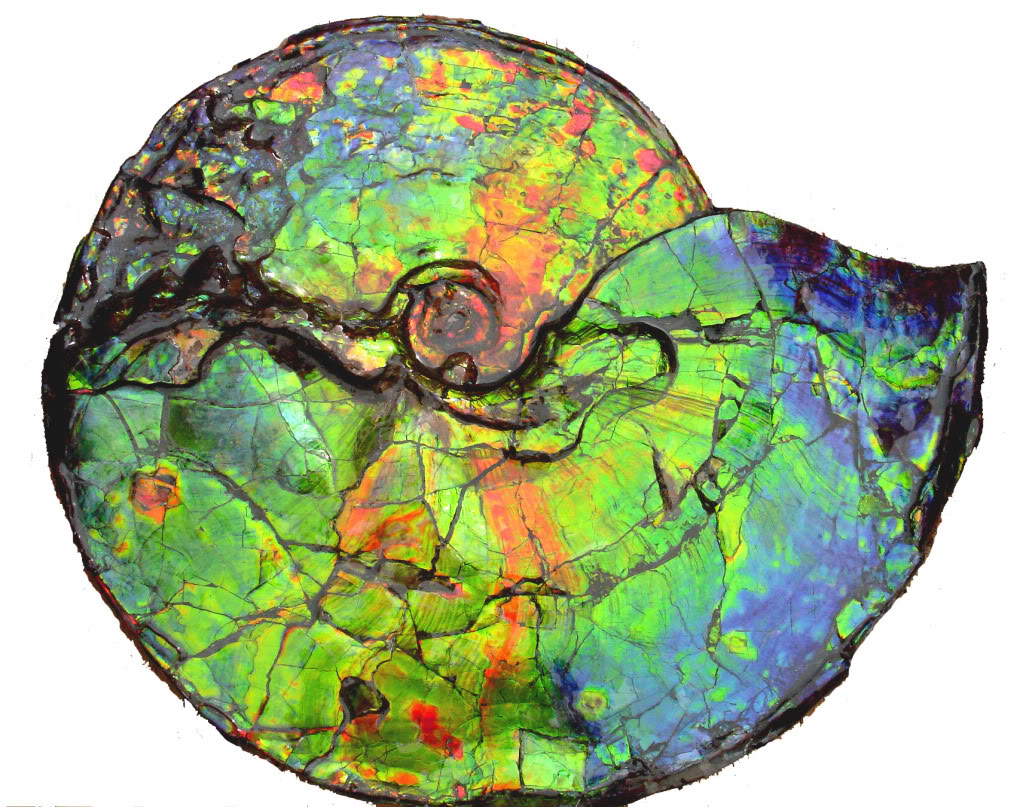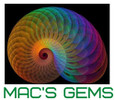Recognized by CIBJO, the Colored Stones Commission, in 1981, Ammolite is the latest of only three new gemstones introduced in the last 50 years and one of three organic gemstones (including amber & pearl) and has been compared to Opal.
Also known as Calcentine, Korite, Aapoak (Blackfoot for small, crawling stone), Ammonite Shell or Gem ammonite, Ammolite is the fossil shell of the Upper Cretaceous Ammonites: Placenticeras meeki, Placenticeras intercalare & Baculites compresses.
Found only in the Bearpaw formation that extends from Alberta to Saskatchewan in Canada and to Montana in the USA, the best grade of gem quality Ammolite is along high energy river systems on the eastern slopes of the Rockies in southern Alberta. Most commercial mining operations have been conducted along the banks of the St. Mary's River south of Lethbridge.
75 to 70 million years ago this was the north-western edge of the Bearpaw Sea. It was a shallow warm water sea that teemed with life. One of the most prolific of it's inhabitants was the ammonite that thrived from deep water bottom feeders to jet-propelled predators that had the biggest brain of it's age. Cataclysmic volcanic activity from the growing rocky mountains periodically covered huge areas with meters of thick ash that settled slowly to the shallow ocean floor killing all life below and sealing their remains in an heavy semi-impermeable layer of mineral rich clay (Bentonite).
Over time the St. Mary River area was buried over 4 km deep (2 1/2 miles) and then underwent geological uplift and eventually surface exposure through many glacial periods. High concentrations of Iron and Magnesium in the volcanic ash created a regionally unique condition that caused sedimentary diagenesis that impeded the oxidization process that converts the aragonite of the ammonite shell to the stable calcium carbonate.
Protected either by large ironstone concretions or a thin layer of iron pyrite, Ammolite has formed in two distinct geological horizons known as the K Zone (crush) and the Blue Zone (sheet). Rate of infill of sea borne sediment into the ammonite chambers could explain the difference between crush and sheet material of iron pyrite.
K zone - always found in concretions, it has been compacted and fractured through deposition and naturally sealed with a carbonate or conchiolin. It is found 120 meters below the top of the Bearpaw formation.
Blue zone - sometimes in concretions, it is usually found compressed with a thin layer of iron pyrite. It is compacted with fewer or no fractures. Rarely mined it is hand collected in a horizon 30 meters below the bottom of the Bearpaw formation in river valleys.

Ammolite is made of Aragonite, the same mineral that makes up Pearls. Unlike most other gem, who's color comes from light refraction, the iridescent color of Ammolite comes from interference with the light that rebounds from stacked layers of thin platelets in the aragonite. Ordered thick stacks for red gem, less ordered thinner stacks for green and unordered, very thin stacks for blue.
Sufficiently thick and durable and with the ability to take a polish to be manufactured into jewelry, the layers are .5 - .8 millimeters thick before polishing and .1 - .3 mm thick after polishing.
Ammolite Gem characteristics
Mineral Name Aragonite
Aragonite
Chemical Composition Calcium Carbonate (CaCO3)
Calcium Carbonate (CaCO3)
Specific Gravity  2.80 - 3.05
2.80 - 3.05
Refractive Index 1.52 - 1.67
1.52 - 1.67
Birefringence 0.135 - 0.145
0.135 - 0.145
Hardness 4.5 - 5.5
4.5 - 5.5
Morphology Crush or Sheet
Crush or Sheet
Crystallography Orthorombic
Orthorombic
Clarity Opaque or transparent or translucent in single layer
Opaque or transparent or translucent in single layer
Luster Vitreous to resinous
Vitreous to resinous
UV fluorescence inert
inert
Parting along flat layers in sheet material
along flat layers in sheet material
Inclusions Pyrite between layers
Pyrite between layers
Durability See below
See below
Enhancements Opticon stabilization
Opticon stabilization
Grading
The Ammolite Industry has yet to agree on any one grading system, however most systems make reference to color, brightness, play of color, etc.
Ammolite Grading
Gem Grade AAA
AAA AA
AA A
A Standard
Standard
Color 3 or more 1 or 2 1 or Pale
1 or Pale Dark / Pale
Dark / Pale
Iridescence Brilliant
Brilliant Bright Included Dull / Dark
Bright Included Dull / Dark
Chromatic Shift Spectro Di
Di Mono
Mono Little
Little
Rotational Range 360° 240°
240° 180°
180° 90°
90°
Ammolite Colors Gemstone Ammonite can be found in any color known in nature and the imagination of man. Or it could have an infinite array of color combinations in every square centimeter. The higher grades will have either a very strong, bright single color or contain a range of bright colors drawn from a color spectrum more vast than a rainbow, while lower grade gemstones will show less vibrant colors in a more limited range. Generally red/green is more common than blue or purple, but there are certain hues, like crimson or violet or gold, derived from any of the primary colors that are very rare and in high demand.
Ammolite Iridescence Ammonite shell is comprised primarily of aragonite with trace elements of aluminum, barium, chromium, copper, iron, magnesium, manganese, silicon, strontium, titanium and vanadium. The spectral property of the mineral aragonite that allows us to see the incredible play of colors across it's surface is it's iridescence. The shell surface is composed of closely packed, tabular, hexagonal crystals of aragonite oriented with their c-axis vertical to the shell surfaces and united into thin lamellae (plates or scales). The thickness of these lamellae is of the same magnitude as the wavelengths of the spectral colors which make up white light. When white light (sunlight) enters the regularly-spaced thin layers of aragonite, diffraction occurs, and flashes of spectral colors are seen. As the plates of aragonite crystals vary in thickness and the addition of the trace elements which are randomly arranged and is interspersed with inclusions of organic material (conchiolin) the intensity of the diffracted colors also varies. The best Ammonite shell will have brilliant, vibrant iridescence, continually dancing with changing colors as the angle of the light changes.
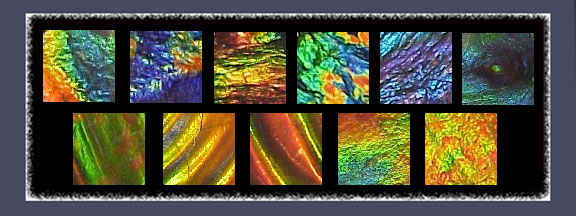
Ammolite Chromatic Shift The color of most Gemstone Ammonite changes dependent on the angle of light entering and the viewers perspective. Sometimes subtle, sometimes dramatic, a chromatic shift occurs. Most red will shift to green and most green will shift blue, etc. This is called dichromatic. Some gem material will have the shift restricted to hues within the same primary color group. This is monochromatic. The best gem material has spectro chromatic shift. Color will shift through the entire spectrum depending on light source and your angle of observation.
Ammolite Rotational Range With the iridescence and chromatic shift variations some material will not show strong, vibrant colors through 360° degrees of rotation. As the gemstone is rotated the brightness decreases and darkens to black. This is due to the light wave diffraction being blocked by the organic inclusions in the aragonite. For a gemstone to be Graded AA it must show a brilliant color through 360° of rotation.
Ammolite is sold in triplets and naturals.
Triplets are constructed of three layers. A dark grey wafer of natural shale sits below a layer of Ammolite. On top there is a calibrated cap of optical quartz or spinel . This assures that the Ammolite gemstone shows the most brilliant flash as well as being durable enough to be worn as every-day jewelry.

Ammolite Naturals are free-form cabochons with a non-coated hand-finish, they are backed by the original shale of the fossil.
Ammolite Patterns
Stained Glass - window panes
Dragon skin - scales
Cobblestone - regular, uneven rows
Floral - flower petals
Ribbon - long thin patterns
Feather - tendrils
Tin Foil - bright crinkle stack pattern
Paintbrush - broad strokes
Moonglow - inner glow, mono or di-chromatic
Ripple - regular striation lines
Pinfire - small plates of changing flash
Sunset - red tinged landscape scenes
Lava River - green with red rivers of lava
Christmas tree - green with red ornaments or freckles
Suture Gem - suture or leaf pattern
Nipplites - three dimensional rainbow eye or tubercle
Ripple - regular spaced rainbow striations or ribs
Banding - distinct color bands
Stain - spreading color changes
Lava lamp - color globules
Terrain - Aerial map
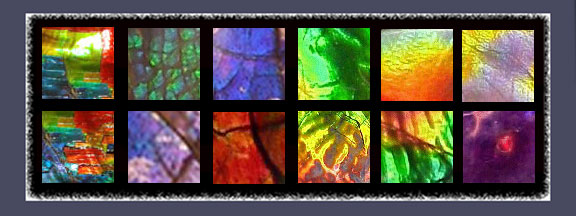
Ammolite & Feng Shui
Feng Shui Master, Edward Kui Ming Li calls Ammolite 'The Most Influential Stone of the Millennium'.
The significant properties of Ammolite are recognized by many experts within the feng shui field.
The gemstone purportedly enhances the flow of 'Qi' (pronounced chi) throughout the body thus lowering our toxicity levels and promoting over all well-being. Ammolites' rainbow of colors is also auspicious. Wealth, creativity, intellect, energy and wisdom are all stimulated and enhanced by Ammolite. The wondrous gem not only brings balance to a person's body, it positively affects our surroundings too. Business dealings will benefit by the presence of Ammolite in your office and within the home Ammolite will contribute to a happy family life. Prosperity and good fortunes are bestowed upon anyone who finds or possesses the gemstone.
Practitioners of feng shui believe that over the last 70 million years this geological phenomenon has absorbed a significant portion of positive cosmic energy from the earth and universe. Energy or 'Qi' is contained within all matter. Light energy is one form of qi and qi radiates from Ammolite in virtually every color of the visible spectrum. Each color corresponds to a specific wavelength of energy and therefore different specific wavelengths can aid in balancing varying areas our personal qi.
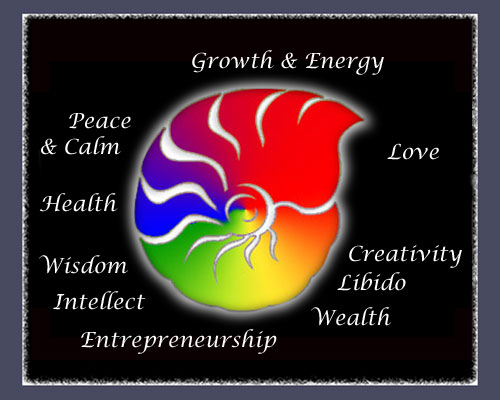
Ammolite has been named the 'Seven Color Prosperity Stone' by feng shui masters. Ruby Crimson, Fiery Orange, Amber Yellow, Emerald Green, Jade, Azure and Mauve all inhabit the swirling, iridescent depths of the gemstone. Ammolites' colorful radiance is especially important in that each color is bequeathed with unique attributes. Reds represent love, stimulates energy and growth, oranges enhance creativity and increases libido, yellows are auspicious for wealth, green represents fertility, encourages entrepreneurship and improves intellect and wisdom, blue embodies peacefulness and calmness and promotes health, purples support power and authority. Our bodies and spirits reap rewards from every color in an Ammolite gemstone.
Good luck and prosperity have been symbolized by shells for many decades in the Far East. Shells are believed to summon and accumulate wealth and prosperity and are a representational symbol for abundance. They are regarded as a means of enhancing clarity, capable of evoking wisdom in decision making and harmonious cooperation.
The iridescent fossil combines the exceptional properties of the Ammolite Gem with the enchanting attributes of the spiral Ammonite Shell. The positive fortune emanating from Canadian Ammolite is simply spectacular and yet there is still more... Feng shui Masters also entertain the belief that ammonites 'hold' the absorbed knowledge of the universe! The distinct paths that the forces of the universe must follow in space are forever mapped by the spiral pattern within the fossils heart. Everyone or everything in the area of the shell absorbs benefits from plasmic energy that gently emanates in centrifugal motion from the storage vaults in the animals' inner whorls. Universal cosmic energy directly influences and enhances health, wealth and enlightenment.
